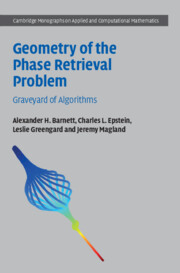Book contents
- Frontmatter
- Contents
- Preface
- Acknowledgments
- 1 Introduction
- Part I Theoretical Foundations
- Part II Analysis of Algorithms for Phase Retrieval
- Part III Further Properties of Hybrid Iterative Algorithms and Suggestions for Improvement
- 11 Introduction to Part III
- 12 Statistics of Algorithms
- 13 Suggestions for Improvements
- 14 Concluding Remarks
- 15 Notational Conventions
- References
- Index
12 - Statistics of Algorithms
from Part III - Further Properties of Hybrid Iterative Algorithms and Suggestions for Improvement
Published online by Cambridge University Press: 21 April 2022
- Frontmatter
- Contents
- Preface
- Acknowledgments
- 1 Introduction
- Part I Theoretical Foundations
- Part II Analysis of Algorithms for Phase Retrieval
- Part III Further Properties of Hybrid Iterative Algorithms and Suggestions for Improvement
- 11 Introduction to Part III
- 12 Statistics of Algorithms
- 13 Suggestions for Improvements
- 14 Concluding Remarks
- 15 Notational Conventions
- References
- Index
Summary
In the earlier chapters of the book, we show that reconstruction algorithms often stagnate at a substantial distance from an exact reconstruction. In this chapter we study the statistical properties of the set of images that result from running such an algorithm with many choices of random starting points. These collections display interesting statistical features: the distribution of errors is multimodal, reflecting the different ways in which an algorithm can stagnate. Sometimes the observable data error is well correlated with the unobservable exact reconstruction error and sometimes it is not. The empirical variances in the approximate phases can be determined on a frequency-by-frequency basis, and provide a good predictor of the accuracy of the mean value of these approximate phases. Algorithms provide a much better estimate of the phases of Fourier coefficients of large magnitude, than for those of small magnitude. As a reflection of the multi-modal character of the data-error distribution, averaging reconstructed images with the smallest data error can improve the accuracy of the reconstruction, but averaging most or all reconstructions does not.
- Type
- Chapter
- Information
- Geometry of the Phase Retrieval ProblemGraveyard of Algorithms, pp. 226 - 248Publisher: Cambridge University PressPrint publication year: 2022

